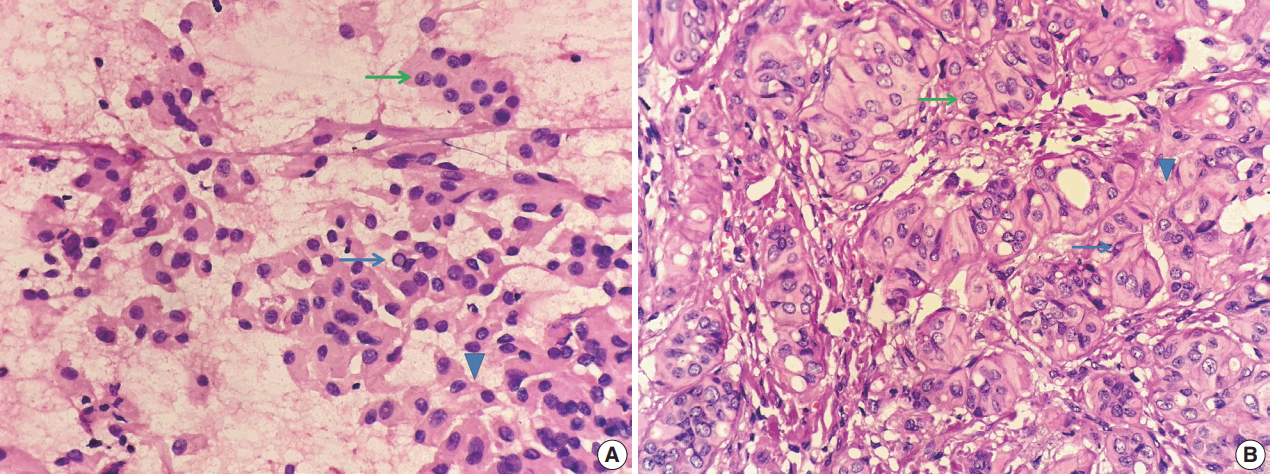1. Shu YJ, Kan X. Cytopathology in China. Zhonghua Bing Li Xue Za Zhi. 2005; 34:625–7.
2. Liu DG. Cytology development in recent 10 years and the future outlook in China. J Am Soc Cytopathol. 2016; 5:10–3.

3. Liu DG. Importance of cytopathology. Zhonghua Bing Li Xue Za Zhi. 2009; 38:799–805.
4. Shen O, Liu SF, Dawsey SM, et al. Cytologic screening for esophageal cancer: results from 12,877 subjects from a high-risk population in China. Int J Cancer. 1993; 54:185–8.

5. Shen Q, Qiu S, Zhao H. Report on cytopathological diagnosis for esophageal carcinoma screening. Chin J Pathol. 1963; 7:19–24.
6. Li FP, Shiang EL. Screening for oesophageal cancer in 62 000 Chinese. Lancet. 1979; 2:804.
7. Peng XJ, Yan XC. Bone tumor cytodiagnosis with fine-needle aspiration: a preliminary report. Chin Med J (Engl). 1983; 96:611–8.
8. Zhang Y. Review and prospect of fifty years of Chinese clinical cytology. Chin J Diagn Pathol. 1999; 6:252–5.
9. Fan YB, Wu X, Fu ZM, Wu GP. Amplification of the human telomerase gene in liquid-based preparations is associated with cervical dysplasia and carcinoma. Int J Gynecol Pathol. 2010; 29:157–64.
10. Nikiforov YE, Carty SE, Chiosea SI, et al. Impact of the multi-gene ThyroSeq next-generation sequencing assay on cancer diagnosis in thyroid nodules with atypia of undetermined significance/follicular lesion of undetermined significance cytology. Thyroid. 2015; 25:1217–23.

11. Nikiforov YE, Carty SE, Chiosea SI, et al. Highly accurate diagnosis of cancer in thyroid nodules with follicular neoplasm/suspicious for a follicular neoplasm cytology by ThyroSeq v2 next-generation sequencing assay. Cancer. 2014; 120:3627–34.

12. Le Mercier M, D'Haene N, De Nève N, et al. Next-generation sequencing improves the diagnosis of thyroid FNA specimens with indeterminate cytology. Histopathology. 2015; 66:215–24.

13. Haugen BR. 2015 American Thyroid Association management guidelines for adult patients with thyroid nodules and differentiated thyroid cancer: what is new and what has changed? Cancer. 2017; 123:372–81.

14. Zhang YZ, Xu T, Cui D, et al. Value of TIRADS, BSRTC and FNA-
BRAFV600E mutation analysis in differentiating high-risk thyroid nodules. Sci Rep. 2015; 5:16927.

15. Liu Z, Song Y, Han B, Zhang X, Su P, Cui X. Non-invasive follicular thyroid neoplasm with papillary-like nuclear features and the practice in Qilu Hospital of Shandong University, China. J Basic Clin Med. 2017; 6:22–5.
16. Zhu Y, Dai J, Lin X, Wu H, Wang T. Fine needle aspiration of thyroid nodules: experience in a chinese population. J Basic Clin Med. 2015; 4:65–9.
17. Cibas ES, Ali SZ; NCI Thyroid FNA State of the Science Conference. The Bethesda System For Reporting Thyroid Cytopathology. Am J Clin Pathol. 2009; 132:658–65.

18. Haugen BR, Alexander EK, Bible KC, et al. 2015 American Thyroid Association management guidelines for adult patients with thyroid nodules and differentiated thyroid cancer: the American Thyroid Association Guidelines Task Force on Thyroid Nodules and Differentiated Thyroid Cancer. Thyroid. 2016; 26:1–133.
19. Kini SR. Thyroid cytopathology: an atlas and text. Philadelphia, PA: Lippincott Williams & Wilkins;2008.
20. Lloyd R, Osamura R, Kloppel G, Rosai J. WHO classification of tumours: pathology and genetics of tumours of endocrine organs. 4th ed. Lyon: IARC Press;2017.
21. Ali SZ, Cibas E. The Bethesda System for Reporting Thyroid Cytopathology: definitions, criteria and explanatory notes. New York: Springer;2010.





 PDF
PDF Citation
Citation Print
Print


 XML Download
XML Download